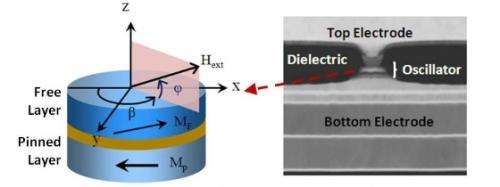Team develops world's most powerful nanoscale microwave oscillators

(Phys.org) -- A team of UCLA researchers has created the most powerful high-performance nanoscale microwave oscillators in the world, a development that could lead to cheaper, more energy-efficient mobile communication devices that deliver much better signal quality.
Today's cell phones, WiFi–enabled tablets and other electronic gadgets all use microwave oscillators, tiny devices that generate the electrical signals used in communications. In a cell phone, for example, the transmitter and receiver circuits contain oscillators that produce radio-frequency signals, which are then converted by the phone's antenna into incoming and outgoing electromagnetic waves.
Current oscillators are silicon-based and use the charge of an electron to create microwaves. The UCLA-developed oscillators, however, utilize the spin of an electron, as in the case of magnetism, and carry several orders-of-magnitude advantages over the oscillators commonly in use today.
UCLA's electron spin–based oscillators grew out of research at the UCLA Henry Samueli School of Engineering and Applied Science sponsored by the Defense Advanced Research Projects Agency (DARPA). This research focused on STT-RAM, or spin-transfer torque magnetoresistive random access memory, which has great potential over other types of memory in terms of both speed and power efficiency.
"We realized that the layered nanoscale structures that make STT-RAM such a great candidate for memory could also be developed for microwave oscillators for communications," said principal investigator and research co-author Kang L. Wang, UCLA Engineering's Raytheon Professor of Electrical Engineering and director of the Western Institute of Nanoelectronics (WIN).
The structures, called spin-transfer nano-oscillators, or STNOs, are composed of two distinct magnetic layers. One layer has a fixed magnetic polar direction, while the other layer's magnetic direction can be manipulated to gyrate by passing an electric current through it. This allows the structure to produce very precise oscillating microwaves.
"Previously, there had been no demonstration of a spin-transfer oscillator with sufficiently high output power and simultaneously good signal quality, which are the two main metrics of an oscillator — hence preventing practical applications," said co-author Pedram Khalili, project manager for the UCLA–DARPA research programs in STT-RAM and non-volatile logic. "We have realized both these requirements in a single structure."
The SNTO was tested to show a record-high output power of close to 1 micro-watt, with a record narrow signal linewidth of 25 megahertz. Output power refers to the strength of the signal, and 1 micro-watt is the desired level for STNOs to be practical for applications. Also, a narrow signal linewidth corresponds to a higher quality signal at a given frequency. This means less noise and interference, for a cleaner voice and video signal. It also means more users can be accommodated onto a given frequency band.
In addition, the new nanoscale system is about 10,000-times smaller than the silicon-based oscillators used today. The nano-oscillators can easily be incorporated into existing integrated circuits (computer chips), as they are compatible with current design and manufacturing standards in the computer and electronic device industries. And the oscillators can be used in both analog (voice) and digital (data) communications, which means smart phones could take full advantage of them.
"For the past decade, we have been working to realize a new paradigm in nanoelectronics and nanoarchitectures," said Wang, who is also a member of the California NanoSystems Institute at UCLA. "This has led to tremendous progress in memory research. And along those same lines, we believe these new STNOs are excellent candidates to succeed today's oscillators."
The paper, "High-Power Coherent Microwave Emission from Magnetic Tunnel Junction Nano-oscillators with Perpendicular Anisotropy," has been published online in the journal ACS Nano.
Other key authors include Hongwen Jiang, UCLA professor of physics and astronomy, and lead author Zhongming Zeng, formerly a postdoctoral scholar in Jiang's laboratory and currently a professor at the Suzhou Institute of Nanotech and Nanobionics, Chinese Academy of Sciences.
Journal information: ACS Nano
Provided by University of California, Los Angeles

















